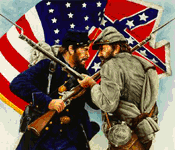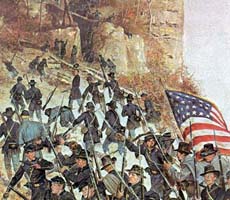 |
Civil War Battles |
|
State War Records |
| AL - AK - AZ - AR - CA - CO - CT - DE - FL - GA - HI - ID - IL - IN - IA - KS - KY - LA - MA - MD - ME - MI - MN - MS - MO - MT - NE - NV - NH - NJ - NM - NY - NC - ND - OH - OK - OR - PA - RI - SC - SD - TN - TX - UT - VT - VA - WA - WV - WI - WY |
The Battle of South Mountain
September 14, 1862 in South Mountain, Maryland
 |
|||||||||||||||||||||
|
After invading Maryland in September, Gen. Robert E. Lee decided to divide his army. Maj. Gen Thomas J. "Stonewall" Jackson was sent to Harpers Ferry to capture the Union garrison and the remainder was continuing to Sharpsburg. The Army of the Potomac, under Maj. Gen. George B. McClellan, pursued the Confederates to Frederick and then advanced on to the South Mountain. The Battle of South Mountain was also known as the Battle of Boonsboro Gap. South Mountain is the name given to the continuation of the Blue Ridge Mountains after they enter Maryland. It is a natural obstacle that separates the Shenandoah Valley and Cumberland Valley from the eastern part of Maryland.
On September 14, pitched battles were fought for possession of the South Mountain passes: Crampton's Gap, Turner's Gap, and Fox's Gap. McClellan, commander of the Army of the Potomac, needed to pass through these gaps in his pursuit of Lee's Army of Northern Virginia. By dusk, the Confederates had been driven back, suffering severe casualties, and McClellan was in position to destroy Lee's army before it could reconcentrate.
Maj. Gen. D.H. Hill and Maj. Gen. James Longstreet defended Turner's Gap against Maj. Gen. Joseph Hooker's I Corps. The Union's Iron Brigade attacked Maj. Alfred H. Colquitt's brigade along the National Road, driving it back up the mountain. To the north, Maj. Gen. George G. Meade's division and the rest of the corps steadily advanced. At nightfall, the Confederates still held the gap. Hill and Longstreet withdrew under cover of darkness. Just to the south, other elements of Hill's division defended Fox's Gap against Brig. Gen. Jesse L. Reno's IX Corps.
On September 15, in the morning, McClellan's limited activity after his victory at South Mountain, however, condemned the garrison at Harpers Ferry to capture and gave Lee time to unite his scattered divisions at Sharpsburg. An attack by Brig. Gen. Jacob Cox secured much of the land south of the gap, but Cox failed to capitalize on his gains as his men were exhausted, allowing Confederate reinforcements to deploy in the gap around the Daniel Wise farm. Reno sent forward the rest of his corps and finally cleared Fox's Gap in the late evening, despite the timely arrival of Confederate reinforcements under Maj. Gen. John B. Hood.
Still further south, Confederate cavalry and a small portion of Maj. Gen. Lafayette McLaws's division defended Brownsville Pass and Crampton's Gap near the town of Burkittsville. Maj. Gen. William B. Franklin's VI Corps carried Crampton's Gap after a series of determined attacks.
By dusk, the Confederates were driven back from South Mountain and McClellan was in position to destroy Lee's army before it could concentrate. McClellan's limited activity after this victory, however, contributited to the Union loss at the Battle of Harpers Ferry and gave Lee time to unite his scattered army at Sharpsburg, for the Battle of Antietam.
Books on The Battle of South Mountain and on Lee's Maryland/Antietam Campaign
available From Amazon.com
